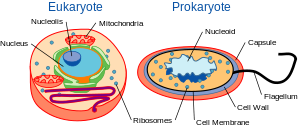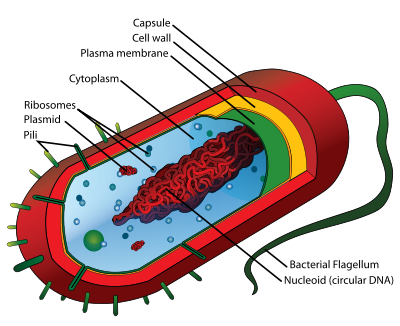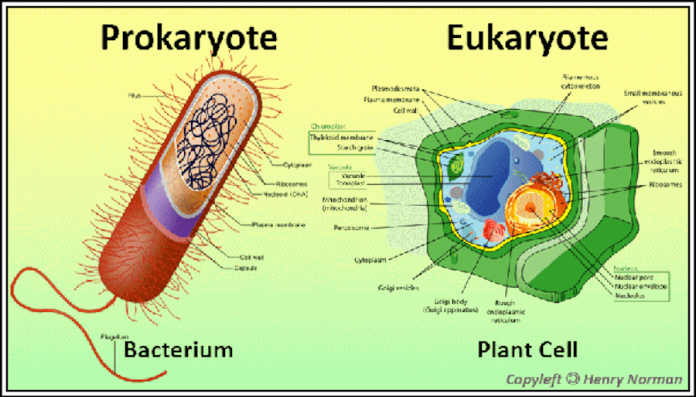These two words are used in describing what is called Prokaryotic and Eukaryotic Cells in scientific biological studies. The link at
http://www.cod.edu/people/faculty/fancher/prokeuk.htm gives the following definitions about these words and the cells that these terms represent.
“Part of our definition/description of what it means to be a living thing on Earth includes the assertion that living things are made of cells and cell products. In other words, we consider the cell to be a pretty fundamental structural aspect of life.
Cells in our world come in two basic types, prokaryotic and eukaryotic. “Karyose” comes from a Greek word which means “kernel,” as in a kernel of grain. In biology, we use this word root to refer to the nucleus of a cell. “Pro” means “before,” and “eu” means “true,” or “good.” So “Prokaryotic” means “before a nucleus,” and “eukaryotic” means “possessing a true nucleus.” This is a big hint about one of the differences between these two cell types. Prokaryotic cells have no nuclei, while eukaryotic cells do have true nuclei. This is far from the only difference between these two cell types, however.”
***
We also have the following information from Wikipedia at link http://en.wikipedia.org/wiki/Cell_(biology) :
“The cell is the basic structural and functional unit of all known living organisms. It is the smallest unit of life that is classified as a living thing (except virus, which consists only from DNA/RNA covered by protein and lipids), and is often called the building block of life.[1] Organisms can be classified as unicellular (consisting of a single cell; including most bacteria) or multicellular (including plantsand animals). Humans contain about 10 trillion (1013) cells. Most plant and animal cells are between 1 and 100 µm and therefore are visible only under the microscope.[2]
The prokaryote cell is simpler, and therefore smaller, than a eukaryote cell, lacking a nucleus and most of the other organelles of eukaryotes. There are two kinds of prokaryotes: bacteria and archaea; these share a similar structure.
The nuclear material of a prokaryotic cell consists of a single chromosome that is in direct contact with the cytoplasm. Here, the undefined nuclear region in the cytoplasm is called the nucleoid.
A prokaryotic cell has three architectural regions:
§ On the outside, flagella and pili project from the cell’s surface. These are structures (not present in all prokaryotes) made of proteins that facilitate movement and communication between cells;
§ Enclosing the cell is the cell envelope – generally consisting of a cell wall covering a plasma membrane though some bacteria also have a further covering layer called a capsule. The envelope gives rigidity to the cell and separates the interior of the cell from its environment, serving as a protective filter.
Eukaryotic cells
Main article: Eukaryote

http://en.wikipedia.org/wiki/Cell_(biology)
Plants, animals, fungi, slime moulds, protozoa, and algae are all eukaryotic. These cells are about 15 times wider than a typical prokaryote and can be as much as 1000 times greater in volume. The major difference between prokaryotes and eukaryotes is that eukaryotic cells contain membrane-bound compartments in which specific metabolic activities take place. Most important among these is a cell nucleus, a membrane-delineated compartment that houses the eukaryotic cell’s DNA. This nucleus gives the eukaryote its name, which means “true nucleus.” ”
Polat Kaya: In this linguistic study, I will show that the words indicated as being “Greek” or Latin actually have a different story behind them.

http://en.wikipedia.org/wiki/Cell_(biology)
Let us first analyze the so-called Greek word “Karyose” supposedly meaning “kernel” – as in a kernel of grain. In other words, this is the “nucleus” of the cell, or, what I call the “heart” of the cell! Thus, according to their definitions, the “Prokaryotic” cells have no “heart” (nucleus) while “Eukaryotic” cells have a “heart” (nucleus).
In this context, when I decipher the Greek term KARYOSE by rearranging its letters as “YOREKSA”, I find that the term KARYOSE is actually an altered, restructured and Hellenized form of the Turkish word “YÜREKSİ” meaning “like heart”. Turkish word “YÜREK” (ÜREK)means “heart”.
Indeed, a “nucleus” in a cell of an organism is “heart-like” and acts like a heart! In fact, similar to this, the “nucleus” of an “atom” is also like the “heart” of an atom – which is like a “solar system” where “electrons” are circling around a central “heart” – just as planets circle around the SUN. In the solar system, the SUN is the “HEART” of the solar system!

http://en.wikipedia.org/wiki/Cell_(biology)#Eukaryotic_cells
Now, in this context, let us understand the make up of the Latin word NUCLEUS. When the Latin term NUCLEUS is deciphered by rearranging its letters as “CUNESLU”, we find that the term NUCLEUS is actually an altered, restructured and Latinized form of the Turkish word “GÜNEŞLİ” meaning “with sun”. Indeed, the “nucleus” represents the heart of a “cell’ as does the nucleus of an atomic structure – just as a SUN represents the “heart” of a solar system! Turkish word GÜNEŞ means “Sun”. Thus, again we find that even this Latin termNUCLEUS has been made up from Turkish – contrary to what we have been taught all this time.
The Greek word EU is said to mean “true,” or “good”. But this supposedly Greek word “EU” is actually the altered and Hellenized form of the Turkish word “EYÜ” (İYİ) meaning “good”. Thus, the prefix EU, appearing in front of the term EUKARYOTIC, is unquestionably from the Turkish language – contrary to what scientists are saying.
Now with these definitions, let us understand the make up of the scientific term PROKARYOTIC – meaning “without nucleus”. When the Latinized term PROKARYOTIC is deciphered by rearranging its letters as “PR-ORAK-YOCTI”, we find that the term PROKARYOTIC is actually an altered, restructured and Latinized form of the Turkish word “BİR ÜREK YOKTİ” (BİR YÜREĞİ YOKTU, YÜREKSİZDİ)meaning “it has no heart”. Indeed, a cell without a “nucleus” has no “heart” as is the case with the so-called “Prokaryotic” cells, (see pictures above).
Now, let us understand the make up of the scientific term EUKARYOTIC meaning “with nucleus”. When the Latinized term EUKARYOTICis deciphered by rearranging its letters as “YUREKCITA-O” we find that the term EUKARYOTIC is actually an altered, restructured and Latinized form of the Turkish word “YÜREKCİTİ O” (YÜREKLİDİ O), meaning “it has heart” (it is with heart). Indeed, a cell with a “nucleus” is a cell with a heart – as is the case in the so-called “Eukaryotic” cells (see pictures above).
***
In addition to these decipherments in Turkish, I would also like to examine some other Latin or Latinized cell related terms such as “cilium,ciliopathies, pilius, flagella, cytoplasm, endoplasmic reticulum”. We use the definitions for such term given in Wikipedia links.
http://en.wikipedia.org/wiki/Cilium
“This article is about organelles. For fine hairs on insect wings, see Cilium (entomology).
A cilium (Latin for eyelash;[1] the plural is cilia) is an organelle found in eukaryotic cells. Cilia are slender protuberances that project from the much larger cell body.[2]
There are two types of cilia: motile cilia and non-motile, or primary cilia, which typically serve as sensory organelles. In eukaryotes, cilia and flagella together make up a group of organelles known as undulipodia.[3] Eukaryotic cilia are structurally identical to Eukaryotic flagella, although distinctions are sometimes made according to function and/or length.[4] ”
Polat Kaya: From the Turkish language point of view, the Latin term CILIUM meaning “hair” or “eyelash” is an important word. It must be noted that even though the word CILIUM is voiced as SILIUM, the first letter C in CILIUM can also be voiced as a K sound – as in the Latin language. By taking the first letter as a K, the Latin word becomes KILIUM. In the context of “hair”, KILIUM is the altered form of the Turkish saying “KILIM” meaning “I am hair” or “my hair”. Thus, we see that the so called CILIUM is actually a Turkish word that has deceptively been “Latinized” – or, in other words, it has been camouflaged in order to hide the Turkish source that it was made from . Turkish word KIL means “hair”. Turkish word for “eyelash” is “KİRPİK”, but by nature, “kirpik” is also a KIL!
It is said that when the CILIA becomes diseased, the emerging class of diseases are called ciliopathies. From the Turkish point of view, this so-called Latin word is also important to note.
When the Latinized word CILIOPATHIES is deciphered by rearranging its letters as “HOSTA-CIL-EIPI”, we find that the wordCILIOPATHIES is the altered form of the Turkish expression “HASTA KIL DİBİ” meaning “sick hair root, diseased hair root” – which describes the hair-root related diseases. So, this so-called Latin word “ciliopathies” has also been made up from Turkish! Turkish wordHASTA means “sick, diseased”, KIL means “hair” and DİBİ means “the bottom part, the root”.
The Latin term Pilus, plural , pili, is described as “a hair or hair-like structure, especially on the surface of a cell or microorganism”. In this Latin term, we again have the bogus letter P that has replaced the letter Q (K) in order to disguise its initial form in Turkish. In the name PILUS, when we replace the letter P with a Q, we end up with the term QILUS – which is the Turkish word KILUZ (KILIZ) meaning “we are hair”. Indeed, what is called PILUS in Latin is the name of KIL in Turkish meaning “hair”. Thus this Latin term has also been made up from Turkish – contrary to denials by “scientific” circles! Additionally, the people who concocted this so-called “Latin” word Pilus identifying the singular hair, actually used KILIZ – which is the plural form of the Turkish word KIL – and, they used KIL – which is the singular Turkish form for “hair” for their plural form pili. This is a further level of confusion and camouflage used to hide away the Turkishness of the source.
***
The Wikipedia link at http://en.wikipedia.org/wiki/Flagella defines the Latinized term “flagellum” as follows:
“A flagellum(plural: flagella) is a lash-like appendage that protrudes from the cell body of certain prokaryotic and eukaryotic cells. The word flagellum in Latin means whip. The canonical role of the flagellum is locomotion but it also often has function as a sensory organelle, being sensitive to chemicals and temperatures outside the cell.”
Polat Kaya: The Latin term FLAGELLUM, when deciphered by rearranging its letters as “GAMFULE-LL”, is found to be an altered and Latinized from of the Turkish expression “GAMGULI EL” (GAMÇILI EL) meaning “hand-with-whip”. This description in Turkish clearly explains the so-called Latin term FLAGELLUM being used as a “hand with a whip” by a cell. Thus, any whip-like movement of the flagellum provides locomotion to the cell. Turkish word KAMÇILI means “with-whip” and EL means “hand”. It should be understood that the letter Fin FLAGELLUM is a bogus replacement for the letter G – which is sometimes voiced like the Turkish letter C.
Alternatively, when the term FLAGELLUM is deciphered by rearranging its letters as “GELLA-FLUM”, we find that it is the altered and Latinized form of the Turkish expression “GILLI ELUM” (KILLI ELİM) meaning “I am hand with hair”. This description in Turkish defines FLAGELLUM as a “hair” that is used as a “waving hand” that gives locomotion to the cell. Turkish word KILLI (GILLI) means “with hair” and ELUM means “I am hand”. It should be understood that, in this case, the letter F in FLAGELLUM is a bogus replacement for the letter E.
***
Associated with the structure of a cell there is the Latinized term endoplasmic reticulum defined as “an organelle of cells in eukaryotic organisms that forms an interconnected network of tubules, vesicles, and cisternae. The rough endoplasmic reticulum is involved in the synthesis of proteins and is also a membrane factory for the cell”.http://en.wikipedia.org/wiki/Endoplasmic_reticulum#Rough_endoplasmic_reticulum
Also from Wikipedia link at: http://biology.about.com/od/biologydictionary/g/cytoplasm.htm we have the following:
“Definition: The cytoplasm consists of all of the contents outside of the nucleus and enclosed within the cell membrane of a cell. This includes the cytosol and in euckaryotic cells, organelles such as mitochondria and ribosomes. Also located within the cytoplasm is the cytoskeleton, a network of fibers that help the cell maintain its shape and give it support.
The cytoplasm is clear in color and has a gel-like appearance. It is composed mainly of water and also contains enzymes, salts, organelles, and various organic molecules. The cytoplasm helps to move materials around the cell and also dissolves cellular waste.”
Polat Kaya: When the Latinized term CYTOPLASM is deciphered by rearranging its letters as “TOC-PAL-SYM”, we find that it is the altered and Latinized form of the Turkish expression “TUZ BAL SUYAM” meaning “I am water with salt and honey”, that is, “water with salt, sugar, organelles and various molecules”. This description in Turkish fits the definition of the term CYTOPLASM. Turkish word TUZ means “salt”,BAL means “honey; sugary liquid”, SU means “water” and SUYAM means “I am water”. The term GEL – as used in the definition above, is a liquid substance similar to honey (BAL in Turkish).
The word ENDOPLASMIC, rearranged as “SPL-ICENDAOM”, is the altered and Latinized form of the Turkish expression“ŞİRELİ–İÇİNDEYIM” meaning “I am inside syrup”. At this point, it is my understanding that the SPL stands for Turkish ŞİRELİmeaning “syrupy”. This view is based upon the fact that the letter P in the Greek alphabet is Latin letter R. This is probably another way of confusing and camouflaging the Turkishness of the source.
The word RETICULUM, rearranged as “CIL-TERUUM”, is the altered and Latinized form of the Turkish expression “KIL DERİYUM” (KILDAN YAPILMIŞ DERİYİM) meaning “I am skin made with hair”.
***
Thus, to our amazement, we find that many scientific terms used in describing the structure of cells (and most likely in other entities as well) are identified as being from Greek and/or Latin terms – but they are not really “Greek” or Latin terms at all. Rather, in their foundations, they are the altered-and-camouflaged forms of Turkish language words and expressions! So, these so-called “scientific” terms are not telling the truth in their etymology – that is, regarding their linguistic make up! In this regard, as my decipherments above show, “western science” has been very lopsided and racist indeed. It has been taking words and expressions from the Turkish language, and after altering and disguising them, then, attributes them to Greek and/or Latin – which are themselves languages that are made up from Turkish! These things are never admitted. They are kept very secret and quiet. Clearly a huge scientific fraud has been going on, most likely, since the time of the Semitic Akkadians invadingSumer and taking everything Sumerian, altering their words, names, traditions and civilization, and then claiming them all – in new forms – as “Akkadian”. That fraud has been copied by others as well and perpetrated for thousands of years up to present times. The ancient TuranianTurkish language, culture, civilization and even the names of some of the ancient Turanian people themselves have been stolen continuously andAryanized. When the youth of an essentially Turanian people are taught with an Aryanized language and identified with Aryanized names, they will surely come to believe that they were truly Aryan people. But, of course, they were not! The world public has been massively deceived by this kind of crookedness. The ancient cabbalistic priests who did these deeds were hoping that their deceit would never be discovered – but, in time, it was. Now we know the other side of the coin.
With my best wishes to all,
Polat Kaya
November 5, 2012

